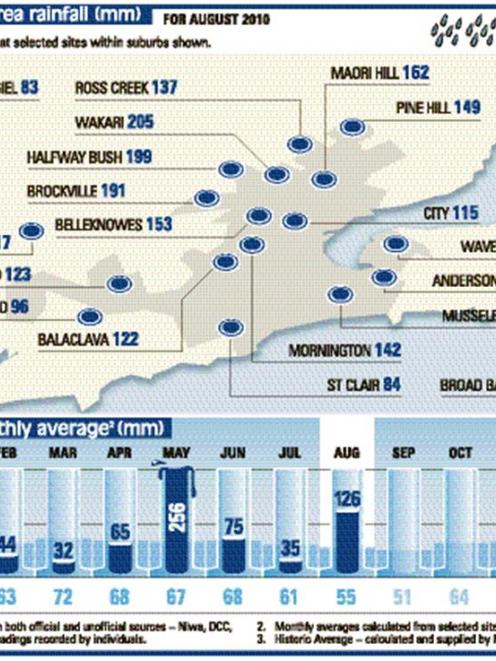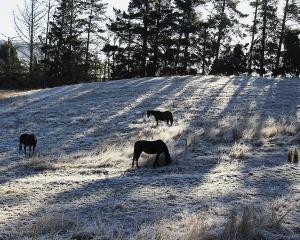
Some low-pressure systems had spread rain to all parts of Otago.
"Easterly quarter winds occurred with these systems from time to time and this provided good falls at times into the areas exposed to those wind directions but not so much in South and West Otago."
Northwesterlies associated with the approach of these weather systems occasionally spread heavy rain to lake areas.
Apart from one cold snap around August 9 and 10, the weather tended to be milder than usual, with significantly fewer frosts over the entire region and not much wind, he said.
"While many farmers reported the ground was quite wet and muddy in places, the positive is that going into spring, soil moisture is good and with temperatures expected to be warming up in September, there should be no barriers to good growth."
Some farmers have reported good growth had already started, he said.
In North Otago August was usually a reasonably dry month but, generally, rainfall totals were at least double their average falls, he said.
Total falls at the indicator sites (average monthly totals in brackets) were:
Waikoura 89mm (26mm), 242% above average; Oamaru Airport 72mm (27mm), 171% above average; Oamaru town 72mm; Kauru the Dasher 64mm (26mm), 144% above average; Islay Downs 79mm (44mm), 79% above average; Palmerston 100mm (38mm), 167% above average.
Significant falls included: August 7-8, Waikoura 42mm, Oamaru Airport 26mm, Oamaru town 28mm, Palmerston 51mm; and August 29-30, Waikoura 25mm, Oamaru Airport 24mm, Oamaru town 21mm, Palmerston 32mm.
Average monthly river flows were well above their long-term averages, he said.
In Central Otago above-average rainfall was recorded.
Total falls were:Lindis Crossing 67mm (39mm), 73% above average; Cromwell 64mm (19mm), 233% above average; Alexandra 23mm (17mm), 40% above average; Hills Creek 90mm (27mm), 233% above average; Merino Ridges 32mm (20mm), 60% above average; Ranfurly 53mm (19mm), 176% above average.
Significant falls included: August 7-8, Tima 23mm; August 12-13, Lindis Crossing 25mm, Cromwell 23mm; and August 18-19, Lindis Crossing 27mm, Cromwell 21mm, Hills Creek 46mm, Ranfurly 26mm.
Average monthly river flows were above their long-term averages for August because of a combination of snowmelt and rainfall.
In Lakes Wanaka, Wakatipu and Hawea and surrounding areas rainfall totals were generally close to or above average, Mr Stewart said.
Total falls were:Makarora Station 228mm (213mm), 12% above average; Hunter Valley Station 125mm (85mm), 48% above average; Hawea Flat 94mm (57mm), 66% above average; Routeburn Station 197mm (183mm), 8% above average; Queenstown 102mm (59mm), 73% above average.
Significant falls included: August 1, Makarora 54mm, Glenfinnan 35mm; August 12-13, Makarora 96mm, Hunter Valley 63mm, Glenfinnan 75mm, Routeburn 88mm, Queenstown 37mm; and August 25-26, Makarora 32mm, Glenfinnan 31mm, Routeburn 31mm.
Average monthly river flows were close to their long-term averages, with occasional higher flows as a result of the heavy rain.
Lakes Wanaka and Wakatipu began the month at 0.6m and 0.4m below their long-term averages of 277.02m and 309.79m respectively. They rose to average levels within the first few days of August and by the middle of August were 0.3m above and close to average respectively. Both stayed close to average until the end of August, he said.
Lake Hawea began the month at 340.78m, 5.2m below full. With increased inflows and Contact Energy reducing its demand on water from this lake, its level remained relatively steady through the month and ended August still at about 5.2m below full.
In Strath Taieri, Lower Taieri and Dunedin above-average rainfall totals were recorded, with the heaviest falls occurring on the hills as was typical with easterly quarter rainstorms, Mr Stewart said.
Total falls were:
Garthmyl Middlemarch 46mm (21mm), 125% above average; Musselburgh Dunedin 68mm (46mm), 50% above average; Maungatua 67mm (54mm), 25% above average; Dunedin Airport 61mm (38mm), 61% above average; Pine Hill 149mm (56mm), 166% above average; Sullivans Dam 193mm (85mm), 126% above average.
Significant falls included: August 7, Middlemarch 22mm, Dunedin Airport 20mm, Musselburgh 19mm, Pine Hill 33mm; and August 29-30, Dunedin Airport 23mm, Pine Hill 51mm, Sullivans Dam 67mm.
Average August river flows were above their long-term averages and rises of 1m-2m occurred with heavier bursts of rain.
In South and West Otago rainfall totals were generally close to or above average, he said.
Total falls were:
Tuapeka Mouth 41mm (441mm), 7% below average; Balclutha 37mm (38mm), 4% below average; Waikoikoi 57mm (67mm), 15% below average; Moa Flat 75mm (48mm), 56% above average; Clarks Flat 51mm (51mm).
Significant falls included: August 7, Balclutha 18mm, Clarks Flat 11mm.
Average monthly river flows were close to or above average in the north and west of this region's rivers, while further south flows were generally below average.







